3. Fixed-term employment relationships decreased in 2009
The general worsening of the employment situation in 2009 was also reflected in fixed-term employment relationships. A total of 310,000 employees worked in fixed-term employment relationships in 2009. This was 22,000 persons fewer than in the previous year. There were altogether 2,123,000 employees in Finland in 2009, which was 84,000 fewer than in 2008.
Approximately 15 per cent of employees worked in fixed-term employment relationships in 2009. The share was slightly smaller than in 2008. In 2009, the number of employees with fixed-term contracts was the lowest since 1997, or the starting year of a fully comparable time series. The share of fixed-term employees among all employees was also at its lowest in 2009. (Figures 10 and 11.)
Figure 10. Number of fixed-term employees aged 15–74 by sex in 1997–2009
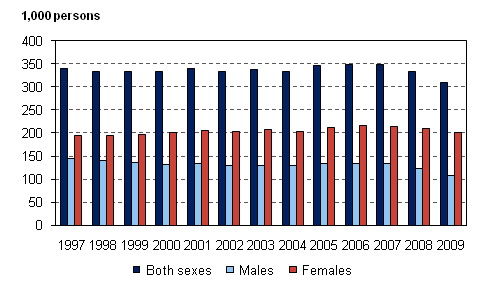
Fixed-term employment is more usual among women than men. In 2009, altogether 201,000 of all fixed-term employees were women while 109,000 were men. The share of fixed-term employees was around 18 per cent among female employees and around 11 per cent among male employees. Both the number and the share of persons employed fixed-term decreased among both genders. Especially male employees’ fixed-term employment relationships decreased from the previous year in 2009.
Figure 11. Share of fixed-term employees among employees aged 15–74 by sex in 1997–2009, %
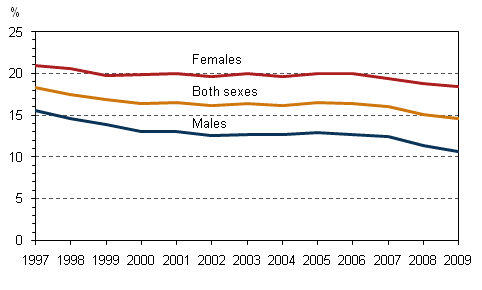
Fixed-term employment shows clear seasonal fluctuation, for the number of fixed-term employment relationships always goes up in the second and third quarters of the year. In 2009, the reduction in the number of fixed-term employment contracts appears to have mainly affected summer jobs, as there were 37,000 fewer fixed-term employees in the second and third quarters of 2009 than in the respective quarters of the previous year.
Fixed-term employment relationships decreased mainly in the private sector (–21,000) whereas in the public sector their number remained almost unchanged. Fixed-term employment relationships diminished most in the industry of manufacturing where their number was 12,000 lower in 2009 than in the previous year. Fixed-term employment contracts also decreased in the industries of construction, and wholesale and retail trade. Health and social work was the only industry where the number of fixed-term employment relationships increased.
3.1 Two out of three fixed-term employees could not find permanent work
To an employee, working fixed-term can be either a desired or involuntary form of employment. Approximately one-quarter of fixed-term employees did not want a permanent job. The majority of them were aged between 15 and 24. Summer workers are a typical group of persons working voluntarily in fixed-term jobs.
However, a more common reason for working in a fixed-term employment relationship is that permanent work cannot be found. In 2009, the lack of permanent work was the reason why around 67 per cent of fixed-term employees worked in fixed-term jobs. In 2009, there were 209,000 fixed-term employees on the labour market who had not found a permanent job even though they would have wanted one. Of them, 137,000 were women and 72,000 men. Involuntary working under fixed-term contracts increases with age.
The number of persons working involuntarily in fixed-term jobs grew by 10,000 from 2008 to 2009. Over the same time period the number of fixed-term employees whom fixed-term employment suited decreased by 16,000. Thus, on the one hand the weakening of the employment situation was seen as reduced hiring of summer workers and, on the other, as increased discretion in hiring people for permanent jobs.
3.2 Around one-half of new employment contracts were fixed-term
New employment contracts with a duration of under one year numbered 392,000 in 2009. This was 78,000 fewer than in 2008. Just over one-half of all new employment contracts were fixed-term. In 2007 and 2008, the share of permanent contracts of all new employment contracts was exceptionally larger than that of fixed-term contracts. (Figure 12.)
Figure 12. New employment contracts with a duration of under one year of employees aged 15–74 in 1997–2009
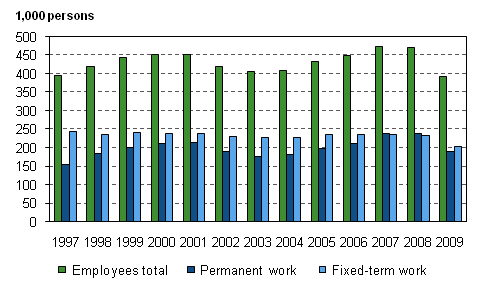
There is a clear difference between women and men in whether a new employment relationship is fixed-term or permanent. In 2009, approximately 58 per cent of women’s and around 44 per cent of men’s new employment contracts were fixed-term. A larger proportion of men’s new employment contracts have been permanent almost throughout the examination period since 1997. By contrast, a clearly larger proportion of women’s new employment contracts have been fixed-term over the same time period.
3.3 Number of persons employed part-time has remained almost unchanged
Persons employed part-time numbered 343,000 in 2009. Of them, 238,000 were employees and 60,000 self-employed persons or assisting family members. The Labour Force Survey data on part-time employment is based on the respondents’ own reporting. The following only concerns part-time employees.
In 2009, the number of part-time employees remained almost unchanged from the previous year. Part-time employees made up 13 per cent of all employees in 2009. The prevalence of part-time employment has not altered much in the past few years. However, the longer term trend in part-time employment has been a growing one since 1997. (Figures 13 and 14.)
Part-time employment is more widespread among women than men. Among female employees, persons employed part-time numbered 202,000, or 18 per cent, and among male employees 81,000, or 8 per cent. Approximately three-quarters of the employees employed part-time worked in the private sector. Part-time working was most frequent in the female dominated industries of wholesale and retail trade, and health and social work.
Figure 13. Part-time employees aged 15–74 by sex in 1997–2009
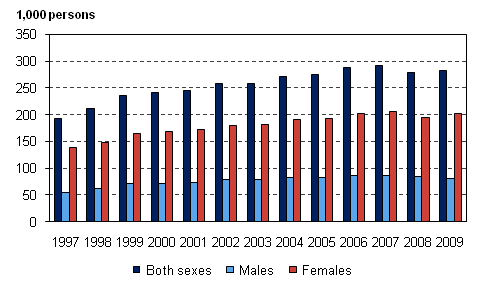
Figure 14. Share of part-time employees among employees aged 15–74 by sex in 1997–2009
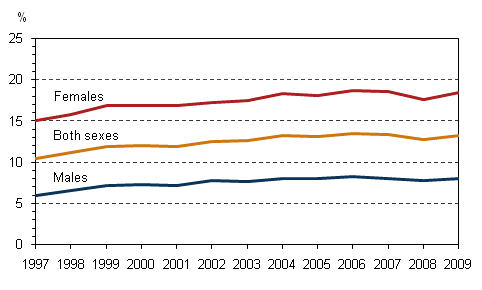
Studying the commonest reason for working part-time
Doing part-time work suits the life situation of many of those who are employed part-time. By contrast, part-time employment can be viewed as one form of underemployment in cases where the employee has not succeeded in finding full-time work even if he/she would have wanted it.
The commonest reason for working part-time was studying. Approximately 30 per cent of part-time employees quoted studying as the reason for working part-time. Indeed, working part-time is widespread among young people, for as many as 40 per cent of employees between the ages of 15 and 24 worked part-time in 2009.
Other reported reasons relating to life situation were caring for children or relatives, and health reasons. Approximately 24,000 persons, almost all of them women, reported caring for children or relatives as the reason for working part-time.
For just under one-third of part-time employees the reason for working part-time was that full-time work was not available. In 2009, the number of employees working part-time involuntarily was 81,000. Of them, 59,000 were women and 22,000 men.
One important reason for working part-time is part-time retirement. According to the Labour Force Survey, 36,000 persons were in part-time retirement in 2009. In the 55–64 age group, the share of part-time employees was 17 per cent. The reasons for working part-time had not changed much between 2008 and 2009.
3.4 Number of hired workers decreased
Data on hired workers have been collected in the Labour Force Survey since 2008. In 2009, the number of persons doing hired work was 23,000. This is 8,000 fewer than in 2008. Thus, the economic recession has also reduced the use of hired workers. Approximately one-half of the persons doing hired work are women.
The share of hired workers among all employees was only one per cent or so in 2009. Thus, doing hired work is quite a marginal form of working on the Finnish labour market. Hired work is mainly done by young people, just under 4 per cent of 15 to 24-year-olds were employed as hired workers.
Hired work is divided between several industries. It is commonest in wholesale and retail trade, hotel and restaurant activities, and in manufacturing. Each of these industries employed a couple of thousands of hired workers. Between 2008 and 2009, the number of hired workers decreased most in the industry of manufacturing.
3.5 Women most often in supervisory posts in the local government sector
Since 2008, the Labour Force Survey has asked employees about the performing of supervisory tasks. In 2009, a total of 19 per cent of employees reported that they were performing some kind of supervisory tasks. Fourteen per cent of women and 25 per cent of men acted as supervisors. The proportions were unchanged from 2008.
The share of women among the employees with supervisory duties was 38 per cent. Women’s share of supervisors was the largest, or as high as 61 per cent, in the local government sector. In the central government sector, 36 per cent, and in the private sector 32 per cent of supervisors were women. Change from 2008 had only taken place in the central government sector where women’s share of supervisors had risen from 30 to 36 per cent.
3.6 Working hours
Working hours change quite slowly. Working hours and hours worked fluctuate according to changes in employment and in the structure of employees. For instance, if part-time work becomes more widespread than full-time work, the number of average weekly working hours falls. Working hours also vary by industry and occupation, as well as by employer sector.
The concepts of working hours used in statistics are usual weekly working hours, hours actually worked per week and hours actually worked per employed. Usual weekly working hours mean the hours an employee normally works inclusive of usual overtime hours. The average of usual weekly working hours is influenced by the form of working hours, i.e. whether full-time or part-time work is concerned. Hours actually worked per week are lowered by absences during the survey week and raised by overtime and extra hours worked. Hours actually worked per employed (or per employee) is a calculated concept in which the number of all hours worked in a year are divided by the average number of employed persons or employees. 1)
Most common working week is 35 to 40 hours
The vast majority (73 per cent) of employees worked a usual week of 35 to 40 hours in 2009. There was very little variation in this between different employee groups. Only one in four of self-employed persons and assisting family members worked a usual week of 35 to 40 hours.
Figure 15. Share of persons working a usual week of 35 to 40 hours by socio-economic group in 2009, %
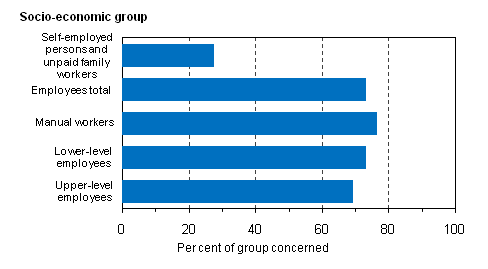
Figure 16 shows the shares of employees and self-employed persons with a short working week of under 35 hours in 2009. Approximately 17 per cent of employees had a short working week. Around one-fifth of lower-level employees had a short working week. Short working weeks were less widespread among upper-level employees. Those with a short working week most typically worked 30 to 34 hours per week. One self-employed person and assisting family member in four had a short working week.
Figure 16. Share of employees working usually a short working week of 1 to 34 hours by socio-economic group in 2009, %
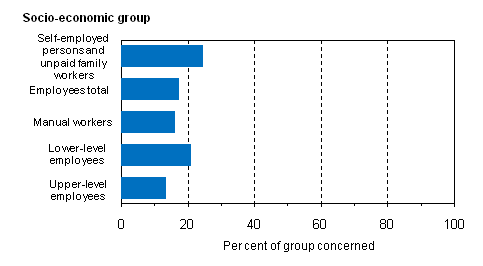
Approximately nine per cent of employees had a long working week of over 40 hours. Among all employees, upper-level employees had most often a long usual working week. Of them17 per cent did long weekly working hours. Long usual weekly working hours were most widespread among self-employed persons and assisting family members, of whom almost 46 per cent usually worked long hours. (Figure 17.)
Figure 17. Share of employees working usually a long working week of over 40 hours by socio-economic group in 2009, %
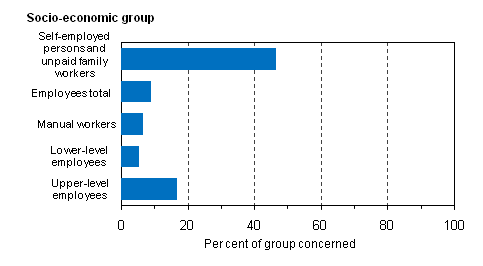
Men’s working week in full-time employment longer than women’s
Average number of usual working hours per week in the main job have hardly changed at all between 2008 and 2009. Employees’ average usual weekly working hours totalled 36.5 hours and their hours actually worked 35.2 hours per week. The longest weekly hours were worked by self-employed persons whose average usual weekly hours totalled 43 and hours actually worked 41,6 hours per week in 2009. Men’s usual working hours and hours worked are longer than women’s (table 1). Hours worked are shortened by holidays and other absences and lengthened by worked overtime hours.
Table1. Average of employees’ usual weekly working hours and hours actually worked per week in full-time and part-time work in 2009
| Usual working hours | Hours actually worked | |||
| Full-time work | Part-time work | Full-time work | Part-time work | |
| Total | 39.0 | 19.8 | 37.4 | 20.2 |
| Men | 39.9 | 18.3 | 38.5 | 19.0 |
| Women | 38.1 | 20.5 | 36.3 | 20.6 |
Managers’ and senior officials’ usual working hours per week in full-time work was on average 41.5 hours (figure 18). Apart from them, only process and transport workers do a usual working week of slightly over forty hours. Office and customer service workers do the shortest working week.
Figure 18. Average of employees’ usual weekly working hours in full-time work by occupation in 2009
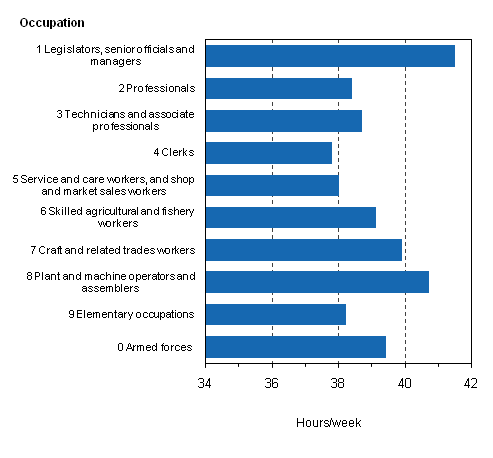
Annual hours actually worked per employee decreased in 2009
Figure 19 compares hours actually worked per employee by employer sector. In recent years, annual hours worked have been almost identical in the private and central government sectors. Hours worked decreased clearly last year, which could be explained by the economic situation which lead to temporary lay-offs and shortening of working hours. Annual hours worked also decreased in the central government sector.
In the local government sector hours worked per year are clearly below those in other sectors, and this has hardly changed at all.
Figure 19. Annual hours actually worked per employee by employer sector in 1997–2009
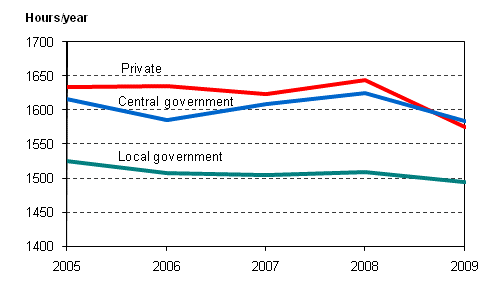
The number of women’s hours worked per employee is around 200–250 lower than men’s. Women, for instance, work more often part-time than men. Family leaves also shorten women’s hours worked more than men’s. Two-thirds of all employees working part-time are women.
The difference between women and men in the number of hours acutually worked per employee was largest in hotel and restaurant activities last year: female employees’ working year was over 300 hours shorter than men’s. Both men’s and women’s annual hours worked diminished last year. Men’s annual hours worked decreased by an average of 70 hours and women’s by just under 40 hours between 2008 and 2009.
Women do more shift work than men
Saturday and Sunday work and shift work represent working hours that deviate from the usual daywork that is done on weekdays. Around 17 per cent of employed persons and 14 per cent of employees did Saturday work during the survey week in 2009 (Table 2). Approximately 12 per cent of employed persons and 9 per cent of employees did Sunday work during the survey week. More than one in four of female employees and around one in five of men did shift work.
Table 2. Share of employed persons and employees having done shift work and week-end work during the survey week in 2009, %
| Employed | Employees | ||||
| Saturday work | Sunday work | Saturday work | Sunday work | Shift work | |
| Total | 17 | 12 | 14 | 9 | 23 |
| Men | 17 | 11 | 12 | 8 | 19 |
| Women | 18 | 12 | 16 | 11 | 27 |
1) N.B. In the annual Labour Force Survey review published on 12 June 2010 and in its appendix tables the expression regular weekly working hours was used of the concept usual weekly working hours. In the past, the expression normal weekly working hours has also been used in the same meaning. From now on, the expression usual weekly working hours will be used in the Labour Force Survey.
Source: Labour force survey 2009. Statistics Finland
Inquiries: Heidi Melasniemi-Uutela (09) 1734 2523, Olga Kambur (09) 1734 3565, tyovoimatutkimus@stat.fi
Director in charge: Riitta Harala
Updated 3.12.2010
Official Statistics of Finland (OSF):
Labour force survey [e-publication].
ISSN=1798-7857. 17 2009,
3. Fixed-term employment relationships decreased in 2009
. Helsinki: Statistics Finland [referred: 4.4.2025].
Access method: http://stat.fi/til/tyti/2009/17/tyti_2009_17_2010-12-03_kat_003_en.html

